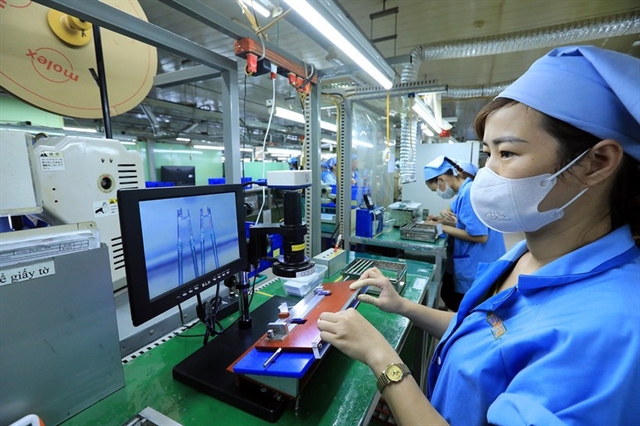 |
| Local consumers shop at BigC Thang Long supermarket in Ha Noi. — Photo cafef.vn |
Viet Nam News HÀ NỘI – According to the Ministry of Industry and Trade, Vietnamese firms would benefit greatly from expanding distribution systems for fast-moving consumer goods (FMCG) in rural markets.
According to Phan Chí Dũng, the Ministry’s Director of Light Industry Department, Vietnamese firms focus predominately on urban markets, even though almost 70 per cent of the population lives in rural areas with huge demands for FMCG such as processed foods, toiletries, soft drinks, and other consumables.
A report about FMCG by market research firm Nielsen published late last month revealed that 54 per cent of FMCG revenues came from rural markets, a modest amount compared to the portion of the population living there.
FMCG sale growth hit three-year high at 6.3 per cent in the second quarter of this year in six major cities and provinces, including Hà Nội, HCM City, Hải Phòng, Cần Thơ, Nha Trang and Đà Nẵng, but nation-wide FMCG sale saw slowdown, largely due to climate change impacts and worries over quality of several beverage products, the report found.
In a country where over half the population is under 30 years old, total consumer expenses are anticipated to double by 2020, which would accelerate sales of FMCG with an average growth of 20 per cent, even higher than India and China. Việt Nam’s FMCG market is expected to touch US$140 billion in revenue this year.
However, amid rapid integration with trade liberalization, competition with foreign rivals in FMCG market is growing fierce, according to the Ministry’s Domestic Market Department.
Made-in-Thailand and made-in-China products are gaining traction in the local market, while foreign giant retailers from Japan, Korea and Thailand are rapidly expanding in Việt Nam
Developing the distribution system to expand in rural markets is essential for local firms, the department said, adding that Vietnamese firms also must enhance product quality and build brand confidence in order to compete with imported products.
Moving online
Global consumer reporting company Kantar Worldpane published a story on September 5 that the value share of e-commerce within FMCG is up 3.9 per cent globally but only up 0.2 per cent in Việt Nam.
The company predicted that e-commerce in Việt Nam will grow more than fivefold by 2020—given widespread smartphones usage in Việt Nam and increasing demand for consumer convenience—and the opportunity is there for someone to jump in and take the lead.
“Yes, e-commerce is tomorrow’s reality of consumer goods products, and the offers as well as the players are going to structure themselves quickly,” Fabrice Carrasco, managing director Kantar Worldpanel Việt Nam, Indonesia and the Philippines, wrote in the report.
There are opportunities for current physical retail giants to move their offerings online, although Fabrice also added that the need could be met by online retail giants like Lazada or Amazon working with manufacturers to list more FMCG online.
Fabrice wrote that another possibility is the rise of independent third party companies who actually don’t own any stores or goods. The business model of companies such as Chopp or MarketOi, who are already operating in Việt Nam, is mainly based on a delivery service, acting as a middle man between the consumer and the traditional offline modern trade. - VNS
 Economy
Economy






